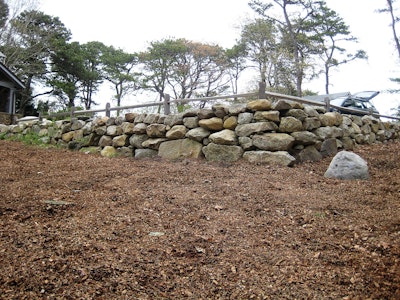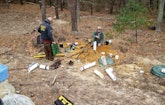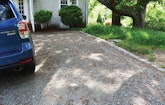
Space is often limited on Martha’s Vineyard. At this property, NitROE equipment is set beneath a driveway. A heavy slab and traffic-rated risers and lids protect the components. (Photos courtesy of KleanTu)
Interested in Systems/ATUs?
Get Systems/ATUs articles, news and videos right in your inbox! Sign up now.
Systems/ATUs + Get AlertsJohn R. Smith had semiretired as an engineer and decided to spend more time in his rental house on Martha’s Vineyard, an island about 4 miles south of Cape Cod, Massachusetts. Then he went to a one-day conference about nitrogen pollution of the island’s nearshore waters, and his plans changed.
The town of Tisbury has 95% of its residences on septic systems and was struggling with nitrogen levels in its estuaries. With the cost of sewers prohibitive, town officials were interested in finding an alternative technology that could reduce nitrogen pollution and be retrofitted on existing home onsite systems or used in new construction. With a grant from the Massachusetts Clean Energy Center, the town and Smith’s company, KleanTu, partnered to develop the NitROE system.
There are 10 pilot systems in the ground in Tisbury, plus an eleventh in the town of Falmouth on Cape Cod. Five of the installations were retrofits where the NitROE system was inserted between the septic tank and drainfield. The other six were on properties where the existing system failed and had to be replaced or where there was new construction.
A tank for carbon
At the core of the NitROE system is a partitioned concrete tank. One-half is an aeration chamber to convert ammonia from the septic tank into nitrate. The other half is filled with wood chips serving as a carbon source for bacteria that convert the nitrate into nitrogen gas, which is vented to the atmosphere.
There is about a 3-inch head difference for effluent moving through the NitROE tank. Wastewater comes in from the septic tank at about 51 inches from the bottom and leaves about 48 inches from the bottom. This is enough to make gravity operate the system. Except for a small external air pump, it’s almost a completely passive technology with no recirculation required, Smith explains.
A standard septic tank with a modified concrete top houses the NitROE equipment. “When we started getting into this, we did not want to come in with different materials than are used with a standard septic system installation,” Smith says.
A plastic baffle forms the partition inside the NitROE tank.
“We use plastic lumber in the baffling because that way it’s going to last forever,” Smith says. This plastic lumber has 60% recycled content, and like the products available at your local home improvement store, it can be shaped with standard woodworking tools for decks or other uses. Metal components are stainless steel.
Wood chips are covered with water, and because oxygen cannot reach them, one fill should last about 30 years, Smith says. When 30 years is up, or if the chips don’t last as long as expected, the chamber can be refilled with fresh chips without excavating the tank, he says. An access port above the wood chip chamber allows a pump truck to vacuum out the chips, just like sludge, and then fresh chips are poured in.
Cost variables
Three installations required 2,000-gallon tanks that are not produced on the island and had to be shipped from the mainland. That added about $4,000 to the cost, Smith says.
NitROE components are installed by KleanTu technicians at a space the company has in the yard of precast tank manufacturer Goodale Construction. Goodale delivers the modified tank as it would any other product.
Retrofits are challenging and can push up the installation cost because what’s in the ground is often a mystery. “An analogy is changing the faucet in an older house,” Smith says. Any owner of an old house knows projects can quickly become complicated.
Elevations can change because pipes and distribution boxes settle, Smith says. Tanks are commonly intact. It’s the pipes and D-boxes that are weak points. “One installer touched a pipe going to a D-box and the D-box crumbled,” he says.
At another home, after installation, the air pump continually kicked off. Smith sent in an electrician who had not worked on the original project, and he found the pump was not on a dedicated circuit. Whenever another appliance came on, the pump kicked off. When the electrician added a dedicated circuit, the problem disappeared.
Experience required
Many localities are looking to improve water quality by reducing nitrogen, so retrofits may be a more common use of this technology. But you need experience to do them, Aaron Fontaine says. He owns Three Star Co. and has installed several NitROE systems into existing treatment trains.
The hard work comes in dealing with old systems and everything else built on top of them. On one job, he had a waterline to the right, a power line to the left, and two more power lines parallel to the road behind him. The leach pit was beneath all that because it had been put in years before the utilities and set so deep that utility workers probably didn’t know it was there, he says.
“You have to know your stuff, just like renovating a house. Once you’re in it, you can’t back out,” Fontaine says. “You can’t take this on and figure a one-day project. If it goes bad, you’re looking at a weeklong project.”
It helps to have an honest talk with property owners, Fontaine says. He would lay out the possible variations that could increase the cost and present the job as an investment.
His machines were a Komatsu 150 excavator and Bobcat S250 skid-steer. Sites were too small to allow the use of anything else.
“The jobs we did couldn’t have been any more challenging unless we ripped out the whole thing and redid it,” he says. “One of them we did — this one was pretty bad, actually — had two leach pits and a distribution box that didn’t work.”
With several jobs behind him, Fontaine says the work will only become easier.
Results
Smith says results from the first set of installations show effluent with total nitrogen less than 10 mg/L on average.
“In addition to significant nitrogen reduction in effluent coming out of the wood chips, we are also seeing suspended solids and BOD both averaging below 30 mg/L. With such results, there is a real opportunity for reducing the size of the leachfield, in my view,” Smith says.
One surprise was the Massachusetts winter. Smith said he anticipated wastewater temperatures would fall from about 70 degrees F in warmer months to about 50 degrees F during winter. Instead, sampling showed temperatures of 39 to 42 degrees F, and that reduced the effectiveness of the systems because lower temperatures reduce leaching of carbon from the wood chips and slow biological activity.
The temperature drop caused a small increase in nitrogen concentrations during the winter, but overall nitrogen removal was still good. Treated wastewater showed nitrogen levels in the range of 10 to 20 mg/L on average. With time, treatment efficiency should only improve after the bacteria acclimate even more to their environment, he says.
Results from last summer show eight of nine installed NitROE systems have average total nitrogen discharges of 5 mg/L while individual unit discharges range between 1 to 8 mg/L, Smith says. In one installation, he says, total nitrogen concentration was reduced from 170 to 5 mg/L.









